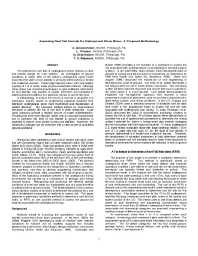Mining Publication: Assessing Roof Fall Hazards for Underground Stone Mines: A Proposed Methodology
Original creation date: March 2006
The potential for roof falls in underground mines remains a clear and present danger for mine workers. An investigation of ground conditions in nearly 50% of the Nations underground stone mines found that the state of roof stability is primarily determined in a limited and subjective manner. These large-opening mines, with roof heights of typically 7 m or more, make physical observation difficult. Although some mines use monitoring techniques to gain additional information on roof stability, this practice is usually short-term and localized to address ground conditions in a particular section or part of the mine. A methodology to assess the risk for a roof fall is proposed in a preliminary fashion based on engineering judgment acquired from extensive underground stone mine experience and examination of related literature. The proposed method uses an observational technique to identify the risk of roof falls in three categories. Case study scenarios provide a realistic picture of model implementation. Providing the mine-level decision-maker with an accurate assessment tool to ascertain the level of risk related to ground conditions is expected to reduce mine worker injuries and fatalities. Moreover, the presences of danger can be overcome with a clear picture of quantified ground conditions.
Authors: AT Iannacchione, LJ Prosser, GS Esterhuizen, TS Bajpayee
Conference Paper - March 2006
NIOSHTIC2 Number: 20029908
2006 SME Annual Meeting and Exhibit, March 27-29, St. Louis, Missouri, preprint 06-059. Littleton, CO: Society for Mining, Metallurgy, and Exploration, Inc., 2006 Mar; :1-9
See Also
- A Computer Software Program that Estimates Air Quantity Requirements in Large Opening Stone Mines
- Diagnosing and Controlling Moisture-Sensitive Roof in Coal Mines
- The Effects of Water Emulsified Fuel on Diesel Particulate Matter Concentrations in Underground Mines
- Optimizing Secondary Roof Support with the NIOSH Support Technology Optimization Program (STOP)
- Pillar Design Issues for Underground Stone Mines
- Preventing Injuries Caused by Unrecognized Stone Mine Roof Beam Failures With a Pro-Active Roof Control Plan
- Roof and Rib Hazard Assessment for Underground Stone Mines
- Roof Span Design for Underground Stone Mines
- Technique to Assess Hazards in Underground Stone Mines: the Roof Fall Risk Index (RFRI)
- Technology News 520 - A Method to Characterize Risk Associated With Mine Roof Conditions
- Page last reviewed: 9/21/2012
- Page last updated: 9/21/2012
- Content source: National Institute for Occupational Safety and Health, Mining Program


 ShareCompartir
ShareCompartir
